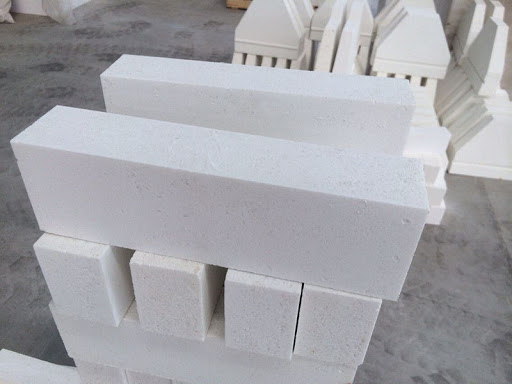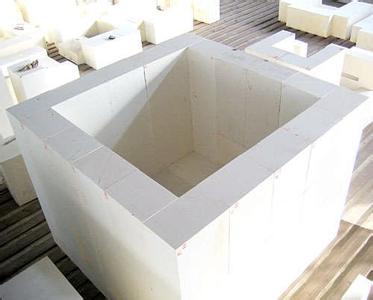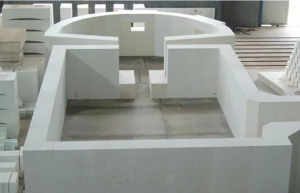Cautions of using electrofused zirconium corundum brick(AZS Bricks)
The following points should be noted during the use of electrofused zirconium corundum brick:
- The erosion resistance of electrofused zirconium corundum bricks manufactured in reducing atmosphere is poor.
Contact between glass phase and high temperature glass solution will produce high viscosity layer, which is the key to good corrosion resistance of zirconium corundum brick. This requires glass phase softening temperature to be high, so in addition to AI2O3, ZrO2, SiO2, Na2O in the brick, other components to be less. However, due to the use of graphite lining brick and graphite electrode in the melting of electric furnace, reducing atmosphere will be generated. C and CO will reduce part of Fe2O3, TiO2 and SiO2 in the melt to low oxide, which makes the component element increase. According to the basic principle of phase ratio, this will lower the liquid phase limit temperature. When such brick is used below high temperature, the viscosity of vitreous phase falls greatly low, the protective layer of high viscosity cannot be formed, vitreous phase viscosity is low, diffuse to high temperature vitreous fluid extremely easily, because this is the crystal phase in brick loses finish mixture also can fall into glaze fluid in, this makes in vitreous fluid produce stripe and stone.

While the electrofused zirconium corundum brick produced by oxidation method does not use graphite lining brick, although the electrode still uses graphite, but uses the long arc method to melt, so that C in the arc and oxygen in the air combine to produce CO2 without entering the molten body. The carbon content of bricks produced by this method is less than 0.005%, so the corrosion resistance is greatly improved.
The zirconium corundum brick also creates bubbles in the glass. This is due to the high reducibility of oxides and other substances such as C in the glass phase of the bricks. As they contact the liquid glass, they capture the oxygen soluble in the liquid glass. This causes the gases soluble in glass to vary in their composition and turn into gases not soluble in the liquid glass, causing them to become bubbles. Such as SO3 dissolved in glass solution is reduced to S02. The solubility of S02 in liquid glass is low and it becomes a bubble. This reduces the quality of the liquid glass.
- Irregular changes in thermal expansion
The structure of fused zirconium corundum brick is stable and compact, and it has strong resistance to glass erosion. Anomalous expansion occurs between 900 °C and 1200°C, which is caused by the transformation of ZrO2 monoclinic crystal form into ZrO2 tetragonal crystal form, which can be used for reference in the kiln and operation of glass tank kiln.
Due to the influence of other components in AZS brick, the crystal transition temperature fluctuates within ±50°C. The variation in temperature within the range of 950 °C to 1150°C for heating and cooling purposes may not exceed 15°C/h.
The abnormal expansion and contraction of zircon can be buffered by the glass phase without causing cracks. In the late 1970s, 0.15%~ 0.20% B2O3 was introduced into the composition, so that the glass phase contained in AZS brick body not only has better thermal shock resistance, but also has a buffer effect on abnormal expansion. However, large temperature changes or repeated fluctuations within this temperature range can also produce cracking. Therefore, when heating the kiln, the temperature should be stable within the range of 950~1150°C. In the temperature often changes in the parts (such as feeding mouth, etc.) when using, the outside to use other brick protection.

- Electrical insulation
The electrode brick is required to have good electrical insulation at high temperature when using full electric melting and electric melting method. The electrical insulation of corundum brick is good and decreases with the increase of temperature. It can be seen that zirconium corundum brick can be used as electrode brick in the production of soda-calcium glass furnace. But when producing high borosilicate glass, azS-41 brick or zircon brick is used. Otherwise, not only the power consumption can not be controlled, but also will melt the brick, damage the electrode, pollution glass liquid.
- Thermal conductivity
The thermal conductivity of zirconium corundum brick is 2 times that of clay brick. Therefore, a large amount of cooling air is needed near the liquid level for this type of pool wall brick, which should be twice as large as that for clay brick. In order to achieve sufficient cooling effect, so that the advantages of zirconium corundum brick fully play.
- The difference between AZS and AL2O3 fused bricks
Under high temperature, the glass erosion resistance is as follows: AZS-41#>AZS-36#>AZS-33#>α-β-A12O3, but the pollution resistance of AZS brick is not as good as alumina electroforming brick. This is because the alumina electrocast brick is very pure, more than 90% are AI2O3, in the glass liquid brick surface generated nepheline metamorphic layer of viscosity is not as large as the nepheline metamorphic layer containing ZrO2, it is relatively easy to melt, so the high temperature corrosion resistance is not as good as AZS electromelted brick. But because the impurities in the glass liquid and the glass liquid viscosity difference is more difficult to dissolve and eliminate, and the alumina brick nepheline metamorphic layer viscosity is small, easily soluble in the glass liquid, so the pollution of the glass liquid is small.

